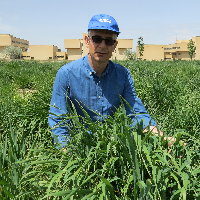Evaluation of variation in Dactylis glomerata L. Populations in terms of yield and related traits under climatic conditions of Tabriz
Orchardgrass (Dactylis glomerata L.) is a perennial forage grass, wind-pollinated and out-crossing that belongs to the Poa ceae family, which is used for pasture, rangeland renovation and hay production. The aim of this study was to investigate the genetic diversity of D. glomerata populations using morphological markers to identify high yielding populations. For this purpose, 25 populations of D. glomerata were sown on a randomized complete block design with three replications in the research farm of the Agricultural Biotechnology Research Institute in Tabriz in the 2018-2019 cropping year. The results obtained from the analysis of variance showed a significant difference in the studied traits, indicating high genetic diversity among populations. Based on the mean comparison results, G2, G5, G14, G16, G18, G19, G24 and G25 populations with 312-342 g/plant in terms of forage yield and G7, G8, G2 and G16 with 27-35 g/plant in terms of seed yield were identified as the best populations. Therefore, G2 population from Shahroud and G16 population from Isfahan were the two top populations in terms of seed and forage yield. Cluster analysis was performed and populations were classified into four groups based on the studied traits. The cluster3 with seven members included most of the top populations. In this study, the highest genetic distance was related to the populations of clusters 1 and 3. In order to produce synthetic cultivars, the parental plants for polycross should be selected from these groups.
-
Evaluation of some Phalaris aquatica genotypes based on agronomic traits
Mohammadhossein Jafarpour, Alireza Pourmohammad *,
Journal of Crop Science Research in Arid Regions, -
ارزیابی سه گونه فسکیوی بلند، علف پشمکی و علف باغ از گندمیان علوفه ای برای تولید علوفه در زیست بومهای زراعی مناطق سرد و معتدل
*، بابک ناخدا، صالح امیری
نشریه علوفه و خوراک دام، پاییز و زمستان 1402



